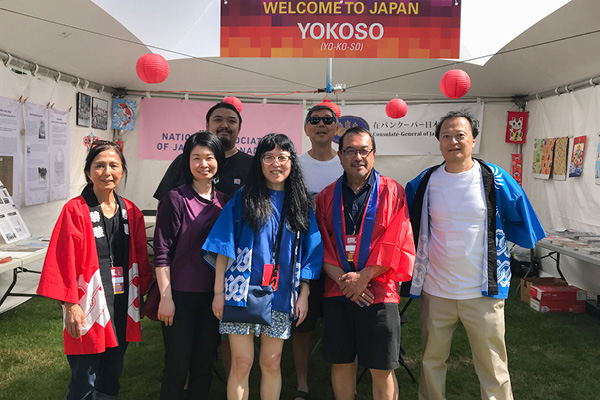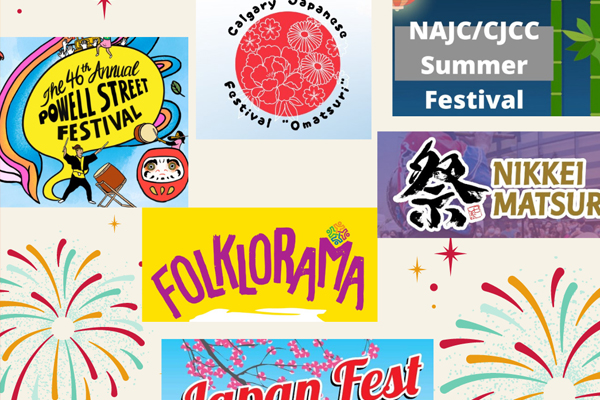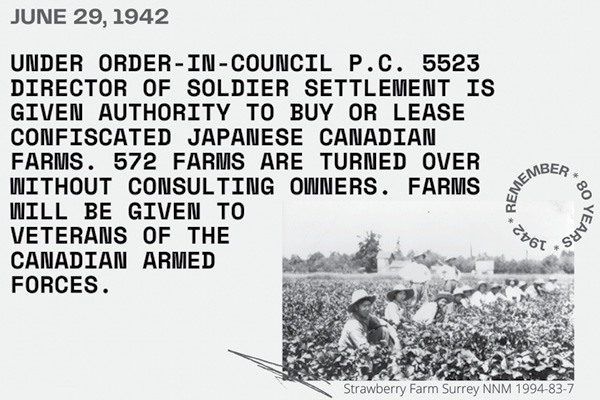by Lorene Oikawa
The woman was gazing intently at the banners highlighting stories of Japanese Canadians in Surrey in the Japan / Japanese Canadian Pavilion I organized with the Japanese Canadian community at the Surrey Fusion Festival. I let her know the material was from a special exhibit that had been at the Museum of Surrey. She said, “I’ve lived in Surrey and never knew these stories. More people should know these stories.” I agreed and shared that I am a fourth generation Japanese Canadian who grew up in Surrey.
The comments won’t be a surprise to you. There are gaps in Canadian historical accounts. Our summer has been filled with festivals and in-person gatherings which will continue into the fall. Each event is a learning opportunity, and we can fill in the gaps by sharing Japanese Canadian stories.
I worked with the curator at the Museum of Surrey (MOS) to obtain stories and a special side exhibit was developed and shown along with the Broken Promises exhibit that was at MOS earlier this year. Broken Promises is now at the Royal BC Museum in Victoria and will be travelling to other locations.
Broken Promises was one of the outputs of the Landscapes of Injustice (LOI), a project that focused on the dispossession of Japanese Canadians. NAJC was a partner, and I was the vice chair of the steering committee. We had our final gathering this year. NAJC is a partner in a new initiative, Past Wrongs, Future Choices which expands on the sharing of the stories of uprooting, dispossession, internment/incarceration and exile from the Americas and Pacific. The meetings start in September. It will be fascinating and sad to hear and learn about the injustice of those of Japanese descent in different countries.
Our Japanese Canadian stories, our history starting from the 1800s was removed along with the forced removal of our families in 1942. When the BC legislature recognized the injustice in 2012, it was a reminder for Japanese Canadians of the complicity of the BC government and the losses of freedom, human rights, property, possessions, education, careers, and in some cases families who were separated. I spoke to the politicians about the importance of meaningful action.
In 2018, as Vice President of the National Association of Japanese Canadians I set up a meeting with Premier John Horgan, President David Mitsui and the BC presidents of NAJC member organizations. We repeated the need for meaningful action and set in motion the plan for community consultations and BC Redress. This major initiative involved many volunteers and a lot of behind-the-scenes work. With the historic announcement of a $100 million commitment by Premier John Horgan this year, the meaningful work on legacy initiatives to honour survivors, our families, continues. BC Redress Director Susanne Tabata is working on the set up of a new society to administer funds.
We are also seeing meaningful action for the survivors and descendants of persons who were harmed by Mr. Nakayama, a former Anglican priest. I was part of the community group who secured the apology of The Anglican Church of Canada in 2015. Last year, the Anglican Church agreed to provide $610,000 towards a healing fund administered by the NAJC. Submission of funding requests have started and a workshop on intergenerational trauma and healing will take place this fall.
2022 is the 80th anniversary of the start of internment/incarceration in 1942 and the 75th anniversary of the founding of the National Association of Japanese Canadians and we are still collecting and sharing family stories. The NAJC started as the National Japanese Canadian Citizens Association which was formed at a September 1947 conference by Nisei delegates from across the country which resulted in five provincial chapters. The aims of the organization then and now are to strengthen the Japanese Canadian community across Canada and continue our commitment to human rights for all, especially racialized and Indigenous peoples.
Also, in September we remember the Japanese Canadians from outside of Vancouver who were being held in Hastings Park in 1942. They started arriving in March and by September 1, 1942, the population at Hastings Park was 3,866. Many had already been sent to internment/incarceration camps. By September 30, 1942, Hastings Park Assembly Centre is officially closed. The Hastings Park hospital remains open with 105 people who remain there until March 1943 when the hospital is closed, and the patients and staff are sent to a new Sanatorium in New Denver.
There are four signs at Hastings Park that tell part of the stories in the words of the survivors. The new Japanese Canadian Hastings Park Interpretive Centre Society (JCHPICS) is continuing the work of our community and includes community members. I will be working with the new society on the next phase of the project which is an interpretive centre at Hastings Park. Please consider providing input at bit.ly/Hastings-Park
This fall NAJC is part of two major events, GEI, Arts symposium organized by the NAJC ACE committee and our NAJC Human Rights committee is working on a Human Rights symposium with our Toronto member organization. We are also happy to support and promote member organization and community events.
With all the challenges we’ve faced such as the pandemic, anti-Asian racism, extreme weather and economic hardships, it’s inspiring to see the resiliency of our member organizations and the local JC communities. Thank you for all you do and a personal thank you for all the support you’ve provided to the NEB. We need to have the spirit of gaman (perseverance) and continue to work on making our stories more visible and making our communities stronger, inclusive, and equitable.
Thank you to the NAJC membership for the honour of representing the NAJC as president. The upcoming AGM is when my maximum term as president will be fulfilled. I will then move into the past president role on the National Executive Board. My thanks to my fellow board members, Les Kojima, Naomi Katsumi, Maryka Omatsu, Susanne Tabata, and Stéphane Hamade, and Executive Director Kevin Okabe for their time and effort. The NAJC National Executive Board are volunteers, and use their experience, skills, and abilities to consider what is best for the organization and members across Canada. I will continue to contribute and support the new board.
The National Executive Board wishes you a wonderful safe fall season.



